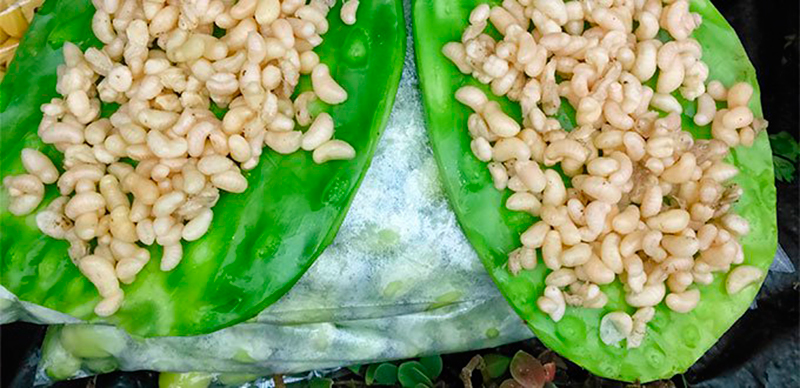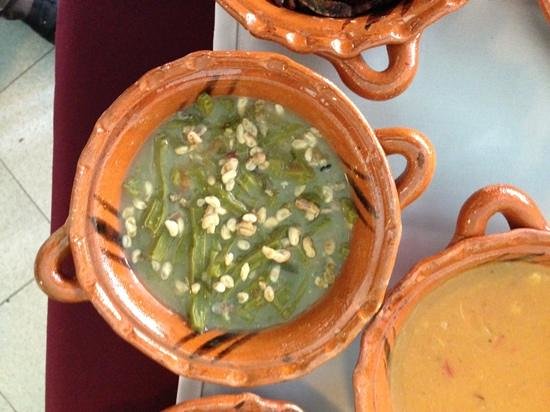Escamoles are the larvae and pupae of Liometopum apiculatum (1) ants, a species of ant in the subfamily Dolichoderinae.
- originally named Formica masonium
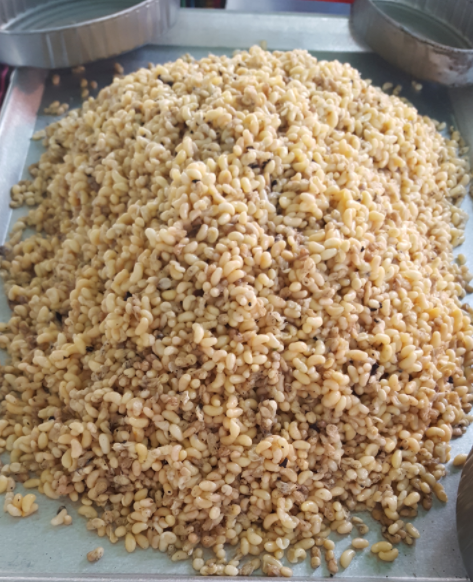
Also called Velvety tree ants, la hormiga pedorra (the farting ant)(1), hormiga güijera, chiquereis, chiquereyes, cuijes, güijes, hormiga de hueva, maicitos, tecates, teclates, tetlames, tetlas.
- so named because of the particular odour of the ants nests and the scent of the crushed ant.
The word escamol is of Nahuatl origin: azcamolli or azcatlmol, from “azcatl” ant and “molli” stew, which refers to a “stew of ants”; another name in Nahuatl is tlilázcatl, which means “black ant”, from “tlilli” black.
Quetzalcoatl is instrumental on the creation myths of mankind in Mesoamerica. It was he who stole the bones of man from Mictlan so they could be reborn in this age of the Fifth Sun. It was he who sprinkled his blood on these bones to give life to mankind. The humans he created however soon became weak. The Gods in Tamoanchan (1) worried. “What shall the humans eat?” It was then that Quetzalcoatl noticed a red ant with a corn kernel. He asked “Where did you get it?” but the ant did not want to say and refused to do so for a long time. It eventually told Quetzalcóatl that Tonacatépetl (2) contained the corn. Quetzalcóatl then transformed himself into a black ant (tlilázcatl) and followed the red ant to Tonacatépetl. After an arduous journey Quetzalcoatl retrieved the corn and introduced it to humanity.
- the verdant paradise of the west, birthplace of Xochiquetzal
- the mountain of sustenance
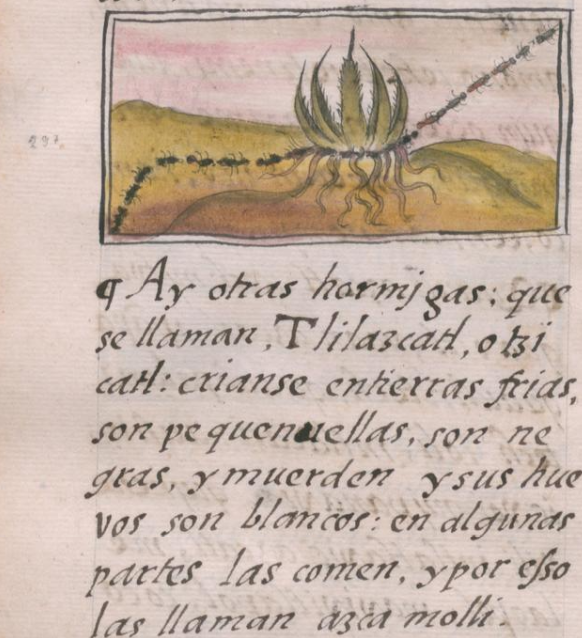
They are native to some semi-arid areas of Mexico and the southern United States. L.apiculatum is distributed in the United States in Arizona, Colorado, Texas and New Mexico, and in 19 states of northern and central Mexico: mainly in Chihuahua, Coahuila, Nuevo León, Tamaulipas, Zacatecas, San Luis Potosí, Hidalgo, Mexico State, the Distrito Federal and Tlaxcala.
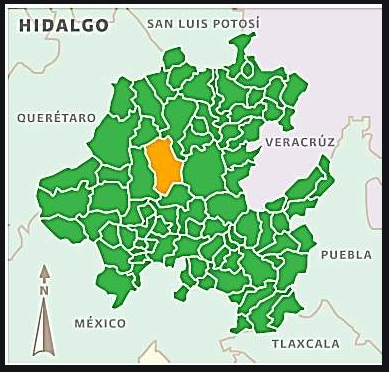
(Map via Melo-Ruiz etal 2016)
In a typically and completely symbolically Mexican way the nests of these ants can be normally be found near the maguey (Agave sp.) plants or nopal (Opuntia sp.) cacti. These plants are sources of sugars and are a valuable foodstuff and defensive home for these insects.
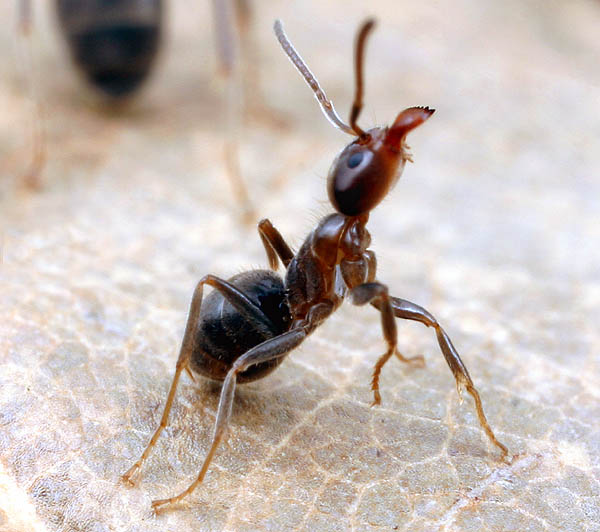
Digging out the underground nests where escamoles are found is hard work. The Liometopum ant is an aggressive little beggar with a powerful bite. This makes the collection of their eggs and larvae an unpleasant and very tough job. This is also exacerbated by the fact that the nest may be found under the less than fluffy agave or nopal cactus.
The nests are regarded as private property and are well cared for. After ants are harvested from the nest the nest is covered with nopal, dried grass, or fresh weeds, in order to maintain an environment suitable for survival and regrowth of the colony.
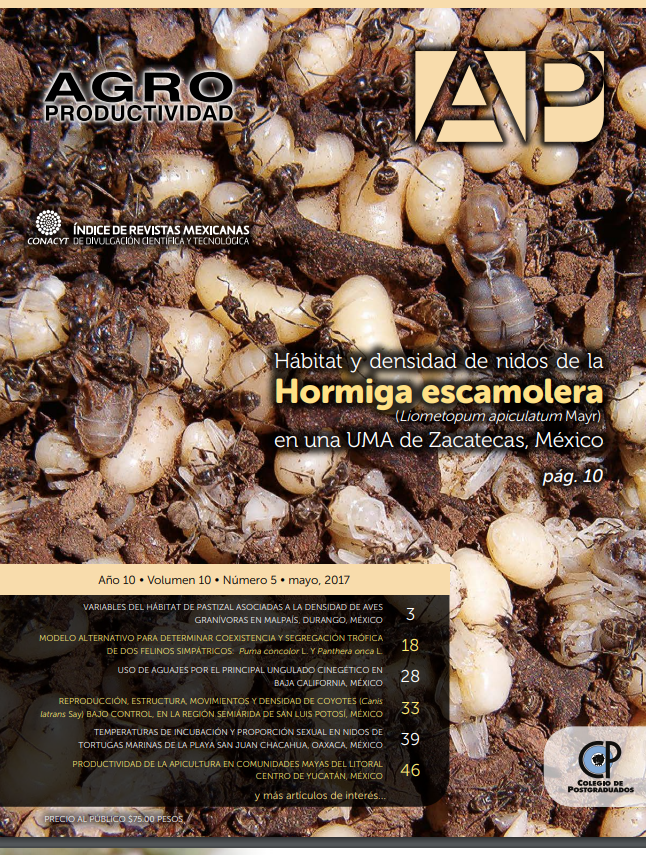
The “eggs” are only available for a short period during the year. They are available only for 10 – 12 weeks between February and April. In Hidalgo they are harvested between February and May. These are warm and dry months, before the first summer rains and prior to the sweltering heat of summer. Weather is highly influential on the ants lifecycle and heavy rainfall in particular can destroy the ants’ nests. Each nest will produce escamoles three to five times during the season. A well-managed nest can be used for 40 years, but the most common is 4 to 12 years (Ramos-Elorduy & Lévieux 1992). It has been reported that “It is widely known among indigenous people, for instance, that escamoles (larvae of the ants of the Liometopum genus) are ready to harvest when the jarilla plant (Senecio salignus) is flowering” (van Huisk etal 2013). In Tepoztlan this plant tends to bloom at the end of February.
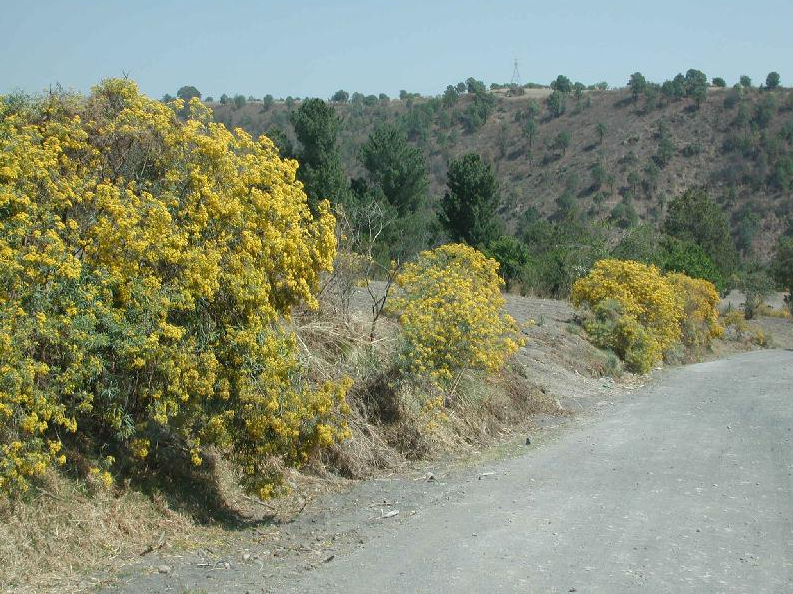
Senecio salignus growing by the roadside in Mexico 
Close up of S.salignus flower
http://www.conabio.gob.mx/malezasdemexico/asteraceae/senecio-salignus/fichas/pagina1.htm
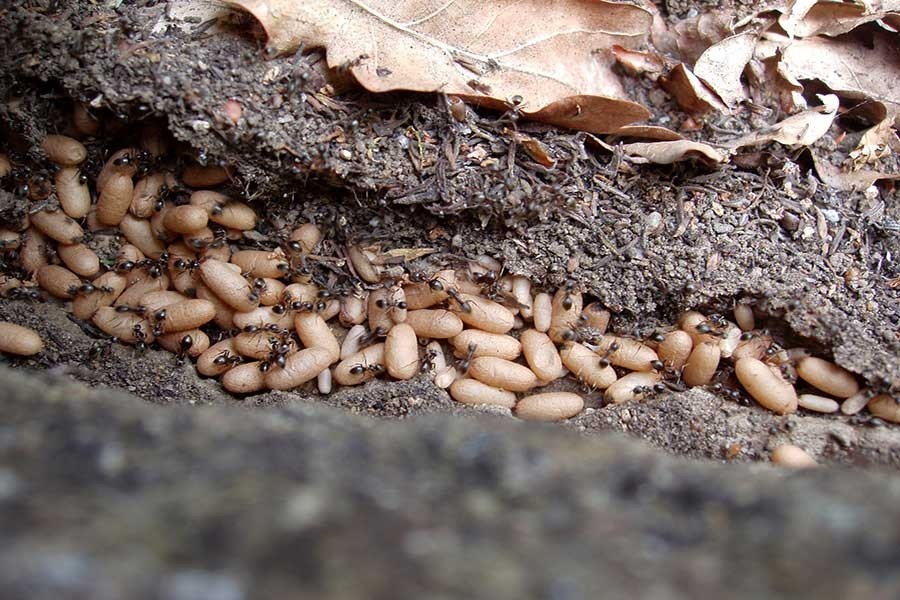
Universidad del Claustro de Sor Juana, México, DF, 2015
www.claustronomía.mx.
Their use as food is an ancient tradition in Mexico and their importance in the Nahuatl culture is reflected by the existence of songs and dances dedicated to these insects (Ramos-Elorduy et al. 1998). They were also part of the tributes for the Aztec Emperor Moctezuma (Ramos-Elorduy 2006).
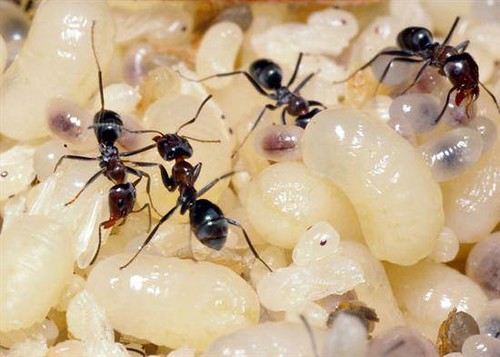
Escamoles tend not to be eaten by the peoples in the areas where they are found. They are seen as a valuable source of income so they are harvested/wildcrafted and sold in the “Big City” where they are considered a delicacy (Melo-Ruiz etal 2016). Escamoles’ market price varies between $35 and $100-$200 USD per kg depending on availability and demand (1). Escamoleros (2), can earn more money during the ant season than most rural persons do during the entire year (DeFoliart 1999)
- Slow Food Foundation for Biodiversity : last accessed 16/04/2021
- people who collect escamoles
They are a potentially endangered foodstuff. There are no official regulations for the rational use and conservation of escamoles and unethical harvesting practices (where the nests are completely destroyed) add to this danger (Lara-Juárez etal 2015)
In Mexico City they are sold in the San Juan and La Merced markets.
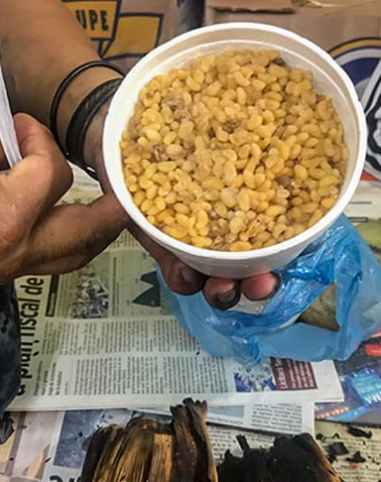
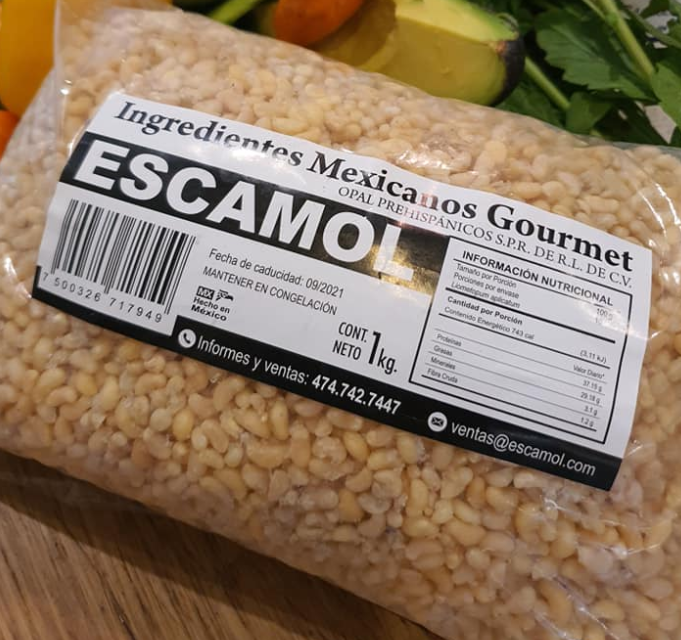
Prepackaged escamoles 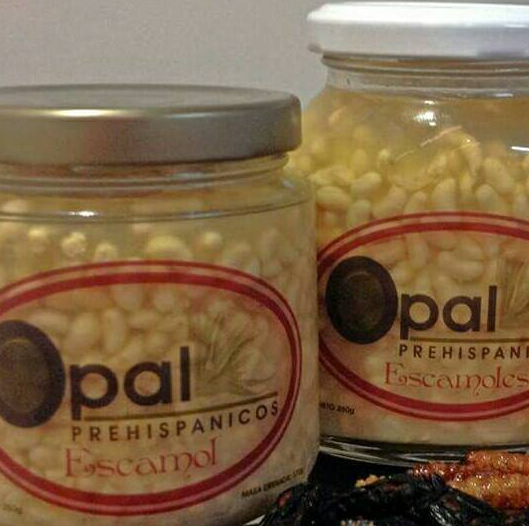
Escamoles bottled in brine.
Due to a high proteolytic enzyme content, escamoles have a very poor shelf life. Escamoles cannot be stored for more than 8 days at 4°C before decay begins to take place. Canning and thermal sterilization as preservation methods may be an alternative for a better utilization of escamoles and could be suitable for creating a new variety of products at a large scale. (Ruiz-Cabrera etal 2015)
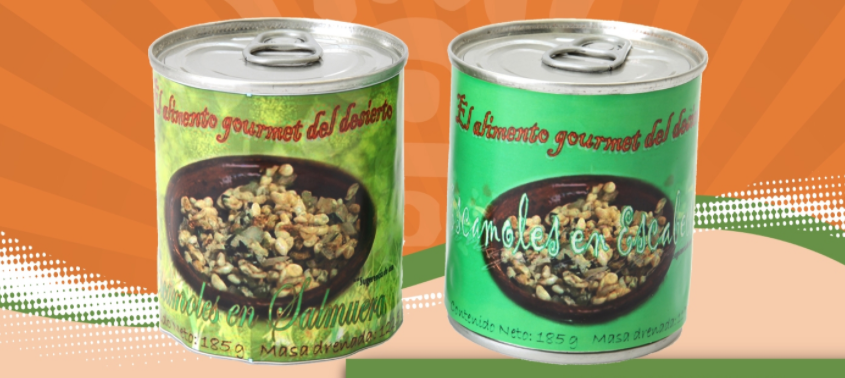
Alicia de Anda Salazar, Raúl González García and Alicia Grajales Lagunes three researchers from UASLP (1) with Sandra Vianey Salas won the 35th National Prize for Food Science and Technology (in 2011), in its student category, with a research and development project that achieved the preservation of escamoles through canning.
- Autonomous University of San Luis Potosí
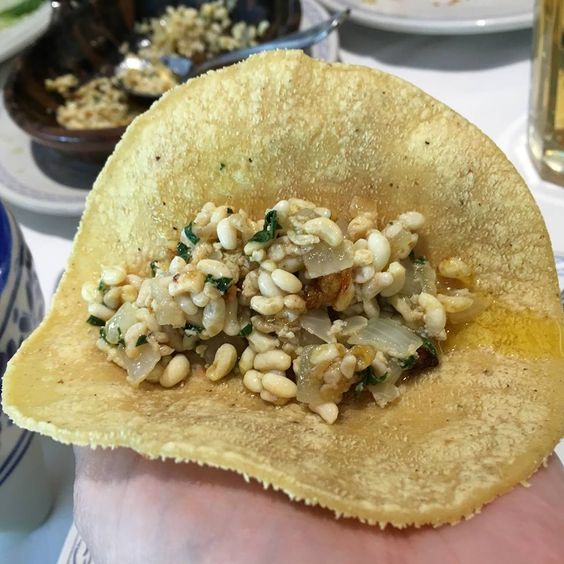
Photo by Jesus Cardoso Moreno 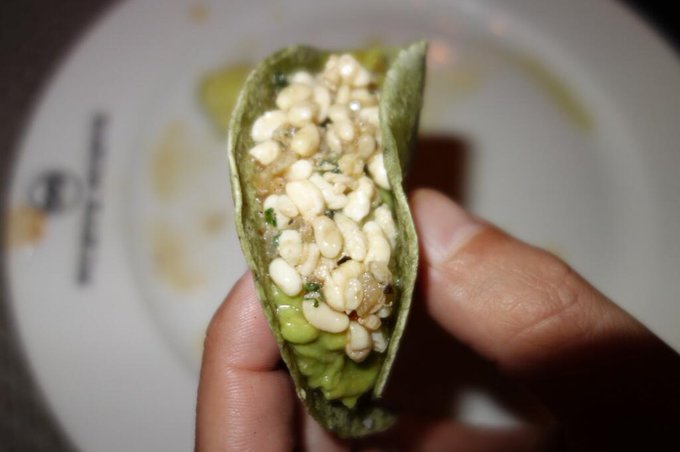
Photo via Concado @ twitter
Tacos de Escamoles

The taste and texture of escamoles are very delicate. They are often referred to as Mexican caviar and are described as having a nutty, buttery (or milky) taste often compared to pine nuts (piñón).
The escamoles are cooked lightly for about 5 minutes until they turn opaque and white or ivory in colour. They are eaten in tacos with corn tortillas or (as seen below) paired with nopal.
Fried Escamoles (Base recipe)
Ingredients
- 100g escamoles
- 50g butter
- 2 sprigs of epazote
- 1 small onion (finely diced)
- fresh Serrano chile (to taste)(finely chopped – seeds and veins removed if you want a less spicy dish)
- Salt
Method
- Place the escamoles in a strainer and gently wash to remove any detritus and dead ants. Drain well
- Melt the butter in a pan and add the onion, the chile and the epazote sprigs
- Fry gently until onion starts to become translucent.
- Add the escamoles and continue frying until they become an opaque white(ish) colour
- Remove the epazote from the pan and serve the escamoles hot, accompanied by tortillas and salsa.

Escamoles can readily be found in the Mexico City restaurant scene.
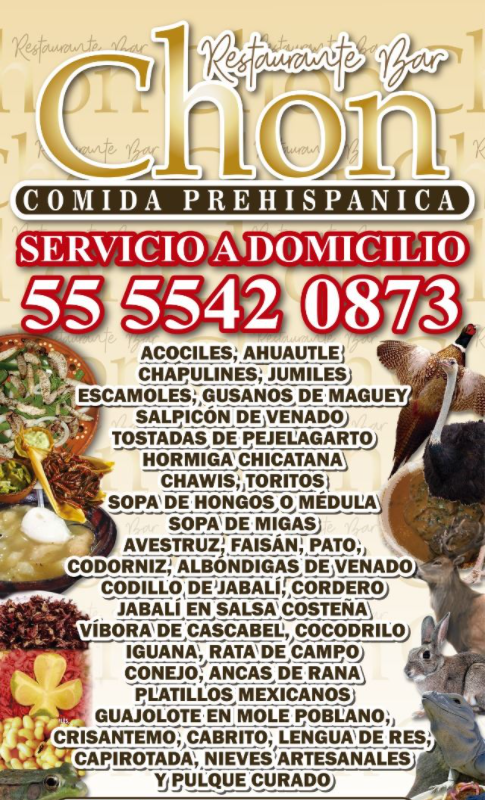
In México City you can visit the Fonda Don Chon. This restaurant specialises in Prehispanic ingredients. The driving force behind this restaurant was chef Fortino Rojas. As a child Fortino began his culinary life selling bunches of cilantro and over time became a taquero. His cooking skills were noticed by Don Encarnación Reyes García the founder of Don Chon. He started at the bottom as a dish pig (dish washer) and worked his way up to the kitchen. In 1981, after Don Encarnación passed away Fortino found himself in charge of the kitchen.
Fortino Rojas passed away in May of 2020.

Fonda Don Chon is still in operation and can be found in Mexico City at Calle Regina 160, Centro Histórico de la Ciudad de México, Centro, 06090 Cuauhtémoc.

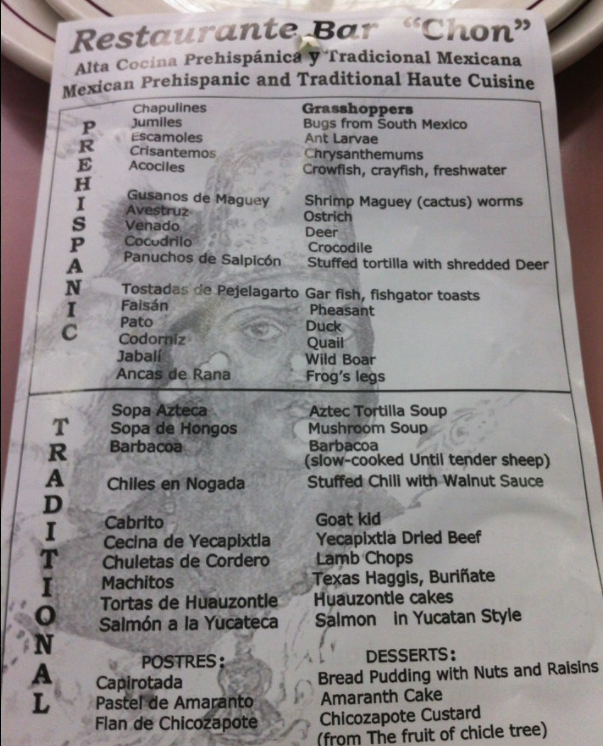
Health Benefits
It has been suggested (Melo-Ruiz etal 2016) that the locals might best be served saving this resource and consuming it at home. The eggs are a valuable source of vitamin A (3024mcg/100g dried weight) which is a valuable resource for the immune system. They also contain Vitamin E (3.29mg/100g) and lipids (34.96g/100g) which may be lacking in an impoverished diet and a 100g portion provides 157 calories and 42g of protein.

Melo-Ruiz (etal 2013) expands somewhat on the nutrient content of escamoles. Using spectroscopic methods (1) six different samples of escamoles from Hidalgo (2) were tested to determine the content of various nutrients (see table below).
- cation exchange chromatography, gas chromatography, high performance liquid chromatography, atomic absorption spectrophotometers
- samples taken in two different months during the spring season of ants’ reproduction

Insects are an excellent source of nutrition and in México many insects are eaten. I will dedicate future Posts to this aspect of Mexico’s culinary cornucopia.
References
- Alatorre-Bracamontes, C.E., Vásquez-Bolaños, M. 2010. Lista comentada de las hormigas (Hymenoptera: Formicidae) del norte de México. Dugesiana 17(1)
- DeFoliart GR. 1999. Insects as food: Why the western attitude is important. Annu Rev Entomol 44:21-50.
- Gordon, D. G. (2013). The Eat-a-Bug Cookbook revised: 40 ways to cook crickets, grasshoppers, ants, water bugs, spiders, centipedes, and their kin (2nd ed.). New York, NY: Ten Speed Press.
- Kodros,C; Lethin,L; and Heller,P : (2012) Folktales of the Nahua: A Journey to Tlalocan : Lulu Publishing Services : ISBN-1483447715
- Lara-Juarez, P., J. R. A. Rivera, P. C. Lara, and J. A. Reyes-Aguero. 2018. Collecting pupae (Escamoles) of Liometopum apiculatum (HYMENOPTERA, FORMICIDAE, DOLICHODERINAE) In the San Luis Potosi high plain, Mexico. Interciencia. 43
- LARA-JUAREZ, Priscila; AGUIRRE RIVERA, Juan Rogelio; CASTILLO LARA, Pedro and REYES AGUERO, Juan Antonio. Biology and use of the escamole ant, Liometopum apiculatum Mayr (Hymenoptera: Formicidae). Acta Zool. Mex [online]. 2015, vol.31, n.2 [cited 2021-04-15]
- Melgar-Lalanne, Guiomar; Hernández-Álvarez, Alan-Javier; Salinas-Castro, Alejandro (2019). Edible Insects Processing: Traditional and Innovative Technologies. Comprehensive Reviews in Food Science and Food Safety, (), –. doi:10.1111/1541-4337.12463
- Melo-Ruiz, Virginia & Quirino-Barreda, Carlos & Calvo-Carrillo, Concepción & Sánchez Herrera, Karina & Sandoval-Trujillo, Horacio. (2013). Assessment of Nutrients of Escamoles Ant Eggs Limotepum apiculatum M. by Spectroscopy Methods. 7. 1181-1187.
- Melo-Ruiz, Virginia & Quirino-Barreda, Carlos & Rafael, Díaz-García & Gazga-Urioste, César. (2016). Consumption of Escamoles (Liometopum apiculatum M.): A Source of Vitamins A and E. Journal of Applied Life Sciences International. 9. 1-7. 10.9734/JALSI/2016/28797.
- Ramos-Elorduy, J., Delage-Darchen, B., Galindo M., NE & Pino M., JM (1988). Bioecotological observations of L. apicultaum M. and L. occidentale var. luctuosum W. (Hymenoptera-Formicidae). Annals of the Institute of Biology, UNAM. Ser. Zoology, 58
- Ramos-Elorduy, J., Muñoz, J. & Pino M., JM 1998. Determination of minerals in some edible insects of Mexico. Journal of the Mexican Chemical Society, 42
- Ramos-Elorduy, J. & Pino M., JM 2001. Vitamin content of some edible insects of Mexico. Journal of the Mexican Chemical Society, 45
- Julieta Ramos-Elorduy (2006). Threatened edible insects in Hidalgo, Mexico and some measures to preserve them. , 2(1), 51–0. doi:10.1186/1746-4269-2-51
- Ruiz-Cabrera, Miguel Angel; De Anda-Salazar, Alicia; González-García, Raúl; Abud-Archila, Miguel; Grajales-Lagunes, Alicia (2015). Experimental and simulated thermal properties and process time for canned escamoles ( Liometopum apiculatum ) under sterilization conditions. CyTA – Journal of Food, 13(2), 188–195. doi:10.1080/19476337.2014.936512
- Trejo Mendoza, Martín, “Mexican caviar: escamoles”, Claustronomy. Digital gastronomic magazine, Universidad del Claustro de Sor Juana, México, DF, 2015, www.claustronomía.mx.
- van Huisk, A; Van Itterbeeck, J; Klunder, H; Mertens, E; Halloran, A; Muir, G and Vantomme, P : Edible insects “Future prospects for food and feed security” FAO FORESTRY PAPER 171 : Food and Agriculture Organization of the United Nations : Rome, 2013; E-ISBN 978-92-5-107596-8 (PDF)


